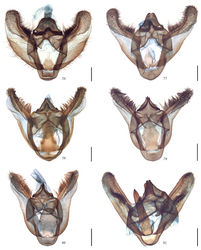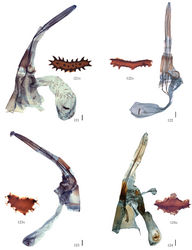Biston suppressaria
| Notice: | This page is derived from the original publication listed below, whose author(s) should always be credited. Further contributors may edit and improve the content of this page and, consequently, need to be credited as well (see page history). Any assessment of factual correctness requires a careful review of the original article as well as of subsequent contributions.
If you are uncertain whether your planned contribution is correct or not, we suggest that you use the associated discussion page instead of editing the page directly. This page should be cited as follows (rationale):
Citation formats to copy and paste
BibTeX: @article{Jiang2011ZooKeys139, RIS/ Endnote: TY - JOUR Wikipedia/ Citizendium: <ref name="Jiang2011ZooKeys139">{{Citation See also the citation download page at the journal. |
Ordo: Lepidoptera
Familia: Geometridae
Genus: Biston
Name
Biston suppressaria (Guenée, 1858) – Wikispecies link – Pensoft Profile
- Amphidasys suppressaria Guenée, 1858[1], in Boisduval & Guenée, Hist. nat. Insectes (Spec. gén. Lépid.), 9: 210. Syntypes 1♂, 2♀, central India.
- Buzura multipunctaria Walker, 1863[2], List Specimens lepid. Insects Colln Br. Mus., 26: 1531. Syntypes 3♂♀, Silhet? (BMNH)
- Biston suppressaria : Hampson, 1895[3], Fauna Br. India (Moths), 3: 247.
- Buzura suppressaria : Prout, 1915[4], in Seitz, Macrolepid. World, 4: 360, pl. 19: i.
- Buzura suppressaria benescripta Prout, 1915[4], in Seitz, Macrolepid. World, 4: 360. Holotype ♂, China: Chung-king. (BMNH), syn. n.
- Biston (Buzura) suppressaria : Wehrli, 1941[5], in Seitz, Gross-Schmett. Erde, 4 (Suppl.): 436.
- Biston (Buzura) suppressaria f. benesparsa Wehrli, 1941[5], in Seitz, Gross-Schmett. Erde, 4 (Suppl.): 436, pl. 36: f. Holotype ♂, China: Hunan, Höng-shan. (ZFMK)
- Biston luculentus Inoue, 1992[6], Bull. Fac. domest. Sci. Otsuma Wom. Univ., 28: 171, figs 59, 60, 62–64. Holotype ♂, Thailand: Chanthaburi, Khao Soi Dao, 400 m. (UOS), syn. n.
Diagnosis
This species is very close to Biston pustulata, but we can distinguish it by the following characters: the protrusion between M1 and M3 of the forewing postmedial line is shorter, shallowly bilobed and sometimes round; the projection between M1 and M3 of the hindwing postmedial line is round. In the male genitalia, it differs in the round apex of the juxta. The diagnostic characters of the female genitalia can be seen in Biston bengaliaria.
Material examineds
CHINA, Hunan (ZFMK): Höng-shan, 900m, 25.V.1933, coll. H. Höne, 1♂ (Holotype of Biston suppressaria benesparsa). Henan: Lingshan, 350 m, 25.V.1999, coll. Shen Xiaocheng, 1♂. Shaanxi (IZCAS): Foping, 900 m, 27.VI.1999, coll. Zhu Chaodong, 1♂. Jiangsu (IZCAS): 2.VIII.1933, 1♂1♀. Anhui (IZCAS): Huainan, 19.VII–2.VIII.1981, 2♂. Zhejiang (IZCAS): Hangzhou, 19.VII–15.VIII.1972, coll. Liu Youqiao, 7♂; Hangzhou, 16.VII–1.VIII.1973, coll. Liu Youqiao and Zhang Baolin, 6♂1♀; Hangzhou, 22.V–17.VI.1976, coll. Chen Yin, 1♂; Tianmushan, V.1936, 2♀; Tianmushan, 30.VII.1972, coll. Liu Youqiao, 2♂; Tianmushan, 24–25.VII.1973, coll. Zhang Baolin, 2♂; Taishun, Siqianzhen, 250 m, 4.VIII.2005, coll. Lang Songyun, 12♂; Taishun, Wuyanling, 400–680 m, 29.VII.–1.VIII.2005, coll. Lang Songyun, 10♂; Hubei (IZCAS):Zigui, Jiulingtou, 220–300 m, 23.VI–25.VII.1993, coll. Song Shimei and Yao Jian, 8♂1♀; Xingshan, Longmenhe, 1350 m, 21.VI–25.VII.1993, coll. Song Shimei and Huang Runzhi, 3♂; Badong, Sanxia Linchang, 180 m, 13–14.V.1994, coll. Li Wenzhu, 2♂; Dangyang, 1980, 1♂. Jiangxi (IZCAS): Dayu, 18.VII.1975, coll. Song Shimei and Zhang Baolin, 2♂; Jiulianshan, 30–31.VII.1975, coll. Song Shimei, 4♂; Dadishan, X.1980, 1♂; Xinyu, VII.1980, 1♂; Boyang, VII.1980, 1♂. Hunan (IZCAS): Changsha, Weishengwusuo, 3.V.1979, coll. Gan Yuankai, 1♂; Yueyang, VI.1981, 1♂; Cili, IV–17.V.1981, 2♂; Fenghuang, 16.IX.1988, coll. Song Shimei, 1♀. Fujian (IZCAS): Mt. Wuyi, Huangxizhou, 500 m, 29.VII.2006, coll. Yang Chao, 1♂; Nanjing, 24.VII.1973, coll. Chen Yixin, 1♂; Sanming, 13.VII–29.VIII.1981, coll. Xiao Hu, 3♂; Jiangle, Longqishan, 10.VIII.1991, coll. Song Shimei, 1♂. Guangdong (IZCAS): Boluo, III.1973, 3♂; Guangzhou, 29.V.1973, coll. Zhang Baolin, 1♂; Guangzhou, VII.1985, coll. Su Xing, 1♂; Yingde, Chayesuo, 30.VII.1979, 1♂; Zhiwuyuan, 13.VI.1978, 1♂. Hainan (IZCAS): Danzhou, Liangyuan, 130 m, 16.V.2007, coll. Han Hongxiang and Lang Songyun, 3♂1♀; Limushan, 26.V.1984, 1♀; Qiongzhong, Limuling, 14.V.2007, coll. Han Hongxiang, 1♂; Baisha, Yinggeling, 434 m, 4–5.IV.2008, coll. Lang Songyun, 7♂1♀; Wuzhishan, Shuiman, 730–900 m, 3–8.V.2007, coll. Lang Songyun, 3♂; Tongshi, 340 m, 28.V.1973, coll. Chen Yixin, 1♂; Baoting, 80 m, 23.V.1973, coll. Chen Yixin, 1♂; Wanning, 60 m, 13.VI–29.VII.1963, coll. Zhang Baolin, 3♂1♀; Wanning, Xinglong, 41 m, 21.III.2008, coll. Lang Songyun, 1♂; Ledong, Jianfengling, 70–828 m, 17–21.V.2009, coll. Yan Keji, 11♂; Ledong, Jianfengling, 828 m, 24–27.III.2008, coll. Lang Songyun, 1♂1♀; Lingshui, Diaoluoshan, 260 m, 5.V.2007, coll. Han Hongxiang and Lang Songyun, 3♂1♀. Guangxi (IZCAS): Longsheng, 10–11.VI.1980, coll. Wang Linyao, 6♂1♀; Guilin, Yanshan, 19.VII.1976, coll. Zhang Baolin, 1♂; Guilin, 23.VI.1980, coll. Zhang Baolin, 1♂; Yulin, 400 m, 15.X.1983, coll. Luo Zhubiao, 1♂; Jinxiu, 200–1100 m, 10–20.V.1999, coll. Han Hongxiang et al., 14♂; Napo, Baihe, 440 m, 7.IV.1998, coll. Wu Chunsheng, 1♂; Qinzhou, 15.IV.1980, coll. Cai Rongquan, 1♂; Nanning, 13.IV.1980, 2♂; Pingxiang, 230 m, 8–17.VI.1976, 5♂2♀. Sichuan (IZCAS):Mt. Emei, Qingyinge, 800–1000 m, 20.V.1957, coll. Zhu Fuxing, 1♀; Yibin, Cuipingshan, 13.VIII.1981, coll. Zhang Yuelan, 1♂. Guizhou (IZCAS): Shibing, Ganxi, 690 m, 29.IV.1979, coll. Liu Wanzhao, 1♀; Jiangkou, Fanjingshan, 500 m, 11.VII.1988, coll. Li Wei, 3♂1♀. Yunnan (IZCAS): Baoshan, Bawan, 1100 m, 19–23.V.1992, coll. Xue Dayong, 2♂; Yongshan, 800 m, 30.IV.1979, 1♀; Lushui, 1250 m, 26.IV.1979, 1♀; Yuxi, Yuanjiang, 4.VII.1978, coll. Jiang Zhaolong, 1♂; Funing, Boyi, 250 m, 17.IV.1998, coll. Zhu Chaodong, 1♂; Cangyuan, 750 m, 19–22.V.1980, coll. Li Hongxing et al., 3♂; Ruili, Dengga, 980 m, 11.V–8.VI.1992, coll. Xue Dayong, 3♂; Wanding, 400 m, 10.VI.1992, coll. Xue Dayong, 1♂; Xinping, Mosha, 800 m, 9.VIII.1980, 2♂; Jingdong, 1170 m, 21.IV–9.VI.1956, coll. Zagwryyw, 2♂; Xishuangbanna, Damenglong, 650 m, 13.VIII.1958, coll. Zhang Yiran, 1♂; Xishuangbanna, Mengzhe, 1200 m, 8.IX.1958, coll. Wang Shuyong, 1♀; Xishuangbanna, 580–700 m, 13–14.IX.1993, coll. Xu Huanli et al, 3♂; Yiwu, Banna, Menglun, 650 m, 29.IV–2.V.1964, coll. Zhang Baolin, 2♀. Tibet (IZCAS): Mêdog, Yarang, 1091 m, 20–23.VIII.2006, coll. Lang Songyun, 1♂. More material from Zhejiang, Hubei, Guangdong, Sichuan and Yunnan in coll. ZFMK.
Distribution
China (Henan, Shaanxi, Jiangsu, Anhui, Zhejiang, Hubei, Jiangxi, Hunan, Fujian, Guangdong, Hainan, Hong Kong, Guangxi, Sichuan, Chongqing, Guizhou, Yunnan, Tibet); India; Burma; Nepal.
Remarks
Prout (1915)[4] mentioned that Biston suppressaria benescripta (Prout, 1915) can be distinguished from Biston suppressaria suppressaria (Guenée, 1858) by the more obvious transverse lines, the absence of the median yellow band and the sparser black dots on the wings. However, after the examination of a long series of material, we find that the form with these variations occurs sympatrically with the nominotypical subspecies, such as in Hunan (Figs 33, 35) and Hainan (Figs 37, 38). And there is no genital difference between the two subspecies. So, we treat Biston suppressaria benescripta as a junior synonym of Biston suppressaria suppressaria.
Biston luculentus Inoue, 1992, described from SE. Thailand, is similar to Biston suppressaria benescripta, but has the transverse lines even more clearly expressed (e.g. see fig. 37 which is almost identical with Biston luculentus). Like Biston suppressaria benescripta, also the Biston luculentus form occurs sympatrically with typical Biston suppressaria suppressaria or with Biston suppressaria benesparsa Wehrli, the latter being a rather rare form, at many places. Also at the type locality of Biston luculentus (Prov. Chanthaburi, Khao Soi Dao) it occurs together with typical suppressaria (coll. ZFMK) Comparison of the genitalia of the two revealed no differences. Thus we follow Stüning (in litt.) and synonymize Biston luculentus with Biston suppressaria. Besides, we also believe that the strange, almost patternless female figured by Inoue (1992)[6] as paratype of Biston luculentus, belongs to another, still unidentified species.
Taxon Treatment
- Jiang, N; Xue, D; Han, H; 2011: A review of Biston Leach, 1815 (Lepidoptera, Geometridae, Ennominae) from China, with description of one new species ZooKeys, 139: 45-96. doi
Other References
- ↑ Guenée A (1858) Uranides et Phalénites 1. In: Boisduval JBAD, Guenée A (Eds) Histoire naturelle des Insectes (Species général des Lépidoptères) 9: i–lvi, 1–514; 10: 1–584; Atlas; pls. 1–22.
- ↑ Walker F (1863) List of the specimens of Lepidopterous insects in the British Museum 26: 1479–1796.
- ↑ Hampson G (1895) The Fauna of British India including Ceylon and Burma (Moths). Vol. 3, Taylor and Francis, London, xxviii+546 pp.
- ↑ 4.0 4.1 4.2 Prout L (1912–1916) The Palaearctic Geometrae. In: Seitz A (Ed) The Macrolepidoptera of the World. Vol. 4, Verlag A. Kernen, Stuttgart, 1–479, pls. 1–25.
- ↑ 5.0 5.1 Wehrli E (1938–1954) Subfamilie: Geometrinae. In: Seitz A (Ed) Die Grossschmetterlinge der Erde. Vol. 4 (Supplement), Verlag A. Kernen, Stuttgart, 254–766, taf. 19–53.
- ↑ 6.0 6.1 Inoue H (1992) Twenty-four new species, one new subspecies and two new genera of the Geometridae (Lepidoptera) from East Asia. Bulletin of Otsuma Women’s University 28: 149-188.
Images
|



